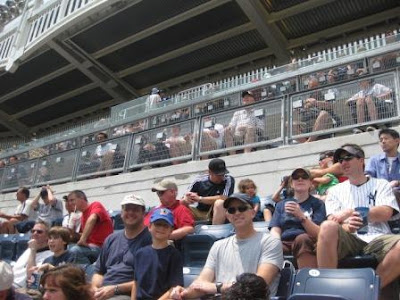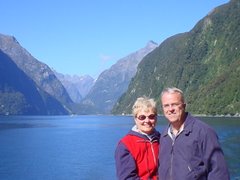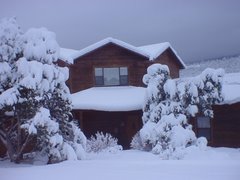
All parties were enthusiastic, so, Saturday, July 25, Jeff, Mike, Jason, and I rendezvoused at LaGuardia airport. (Actually, I rendezvoused with Mike and Jason in Cary, NC a couple of days earlier, then flew to NYC with them -- for logistics and plane-ticket cost reasons.) We had lucked out in lodging because Mike's brother-in-law, Jeff Nauman, has an apartment in NYC that was available -- he's in Interlochen, Michigan for the summer, instructing and performing in their theatre summer camp program.
Jeff's apartment is on the upper west side of Manhattan, in an area called Washington Heights. It's the sort of NY apartment and apartment house you see on Seinfeld, Taxi, Rhoda, or in the movies. One feature is its art-deco lobby, which had been listed as one of NYC's most notable/attractive/interesting apartment house lobbies. Jeff's parents told me that the day the story appeared there were lots of people peering in the lobby windows (there's no Carlton the doorman, but you have to have a key to get in) trying to see what the fuss was all about.

For us, the main attraction was that Jeff's apartment had one bed, a fold-out couch, and an air mattress, and was free. Had good subway access, too.
One nearby attraction that I wanted to see is the Cloisters. My vague, erroneous impression was that this was a former monastery converted into an art museum. Actually, it was built as an art museum, largely with Rockefeller money, styled after medieval monasteries in Europe. Rockefeller even bought New Jersey land across the Hudson River to preserve the pastoral view from the Cloisters. We got there late Saturday afternoon, late enough not to have to pay admission, and took a quick 30-minute walk-through. As they say, Expose yourself to art! Really some beautiful and historic paintings, carvings, and sculpture, dating back to the 1100's and 1200's.

With medieval culture under our belts, we then subwayed downtown to see modern culture - the lights and sights of Times Square.

On weekends the city closes some of the streets in Times Square and provides folding recliners and folks sit around just like any ole backyard.
On Sunday morning it was back downtown to go up in the Empire State Building. Went all the way to the 102nd floor, 1224 ft. up, just beneath the lightning rod on top which extends to 1454 ft. It was a hazy day, so not the best pictures. One oddity: bumble bees flying around at that elevation.
The 102nd floor observatory is enclosed with plexiglass. The 86th floor is not, so you can get better pictures. Looking down from there ...

Then it was on to the new Yankee Stadium for an afternoon game.


The new Yankee Stadium cost $1.4B. It has many of the features of old Yankee Stadium: the facades and the same dimensions of the playing field. However, it seems to be producing more homeruns than were hit in the old stadium, for unknown reasons. The new stadium is adjacent to the old, which is shrouded in scaffolding as they prepare to demolish it.
Jason said right away, The new stadium is not as big as the old one. That looks to be the case height-wise (couldn't find the data right away). The old had three decks essentially stacked one over the other, meaning it was hard for many to see balls hit into the air. The new sweeps back in a flatter slope and the upper two decks are further back from the playing field. The new stadium actually seats about 6000 fewer people, 51,000 vs. 57,000. One reason is that the seats are larger and with more legroom.
One of the controversies about the new field is the ticket cost. Single game tickets were priced at $2600 for behind-home-plate seats. That meant that TV watchers saw largely empty seats, which was embarrassing. They reduced prices a bit. We thought maybe they would pay us to sit there for PR sake, but No. We were in the third level, about even with third base.
One big ticket item is a huge HD screen behind center field. Here's Mariano Rivera warming up as he prepares to efficiently nail down the Yankees' 7-5 victory over Oakland. Any bluriness is in my camera and skill, not the screen.

I came away impressed, but feeling a bit underwhelmed. I think it was the limestone and concrete construction. Felt like I was going into the Pentagon, not a baseball park.
After the game it was back downtown, with two destinations in mind. A friend had suggested the Carnegie Deli to Jeff, so we went there for an early dinner. Sandwiches were mind-bogglingly thick. Here's my BLT and Jason's ham sandwich in the background.

Central Park, our second destination, is just a couple blocks north of the Carnegie Deli. Before we got there, though, it started to rain. More than rain, we had thunder, lightning, and wind. We found shelter under construction scaffolding just across the street from the park. Here, a couple of carriages wait for the storm to pass. As the coachman driving the white coach came down the street (to park at the park), the wind whipped his umbrella out of his hands and it disappeared down the street to our right.

The storm passed, so we went on into the park.

The gold-trimmed building is one of Donald Trump's.

Cheers to all,
Rob






















































